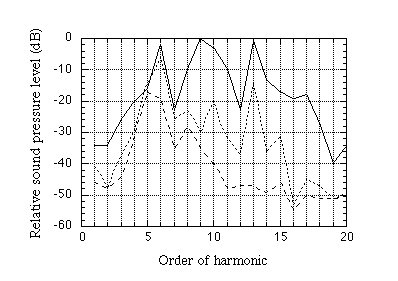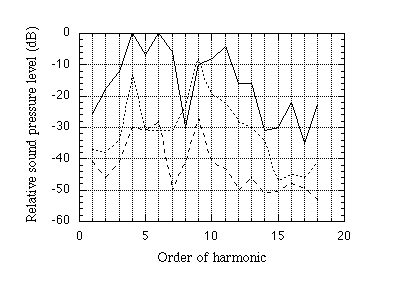Kenshi Kishi - kkishi@peacock.ee.uec.ac.jp
University of Electro-Communications
1-5-1, Chofugaoka, Chofu-shi
Tokyo 182, Japan
Yoshimasa Tohnai
Nihon University's Buzan High School
5-40-10, Otsuka, Bunkyoku
Tokyo 112, Japan
Masashi Yamada
Osaka University of Arts
759, Higashiyama, Kanan-cho, Minamikawachi-gun
Osaka-hu 585, Japan
Popular version of paper 4aMUb2
Presented Thursday morning, 5 December 1996
3rd Joint ASA/ASJ Meeting, Honolulu, Hawaii
Embargoed until December, 5 1996
The biwa is a plucked string instrument belonging to the lute family. Historians are fairly certain that the biwa came from India to China around the 3rd century AD. Here it developed and seems to have been introduced to Japan in the Nara period (8th century AD). The "Satsuma" biwa is a kind of Japanese modern biwa developed further from the "gaku" biwa in the Nara period.
In spite of the same origin, there are important structural differences between modern Japanese biwas and the Chinese biwa (known as "Pi'Pa'"): 1.The frets of Japanese biwas are higher and broader than those of Pi'Pa'. 2.The Japanese biwas have fewer frets (4 or 5) than Pi'Pa'. 3. Japanese modern biwas, especially the Satsuma biwa, have a convex top plate, while Pi'Pa' has perfectly flat top plate.
The aim of our study is to visualize the acoustical characteristics of the tones of Satsuma biwas played by a skilled biwa player, Y. Tohnai, in an anechoic chamber. The tones of every four open strings were played for three biwas, which have almost the same structures but were produced in different eras, i.e., Meiji, Taisho, and Showa. Four open strings from 1st to 4th were tuned to the pitches of A2,E2,A2, and E3(or 110Hz,82Hz,110Hz, and 164Hz), respectively.
In order to study the played tones of the three Satsuma biwas quickly, the sound spectrogram of those tones are obtained. The sound spectrogram is not only the three dimensional presentation in which the time variance of the frequency and the amplitude of harmonics are displayed but also draws the total sound pressure level of the tone. From these sound spectrogram, the following features are found: 1.The time variance of the total sound pressure level depends on strings but is common to every biwa. 2.Fundamental and lower harmonics have much less energy than that of the higher harmonics (from 6th to 10th).
In order to make the relative level among the harmonics and those time variations clear, we conducted Fast Fourier Transform (FFT) analyses. The FFTs when the peak sound pressure is reached, 0.5 seconds after that time, and 1.0 second after that time were obtained. As the FFT contains not only the fundamental and its harmonics but also the non-harmonic tones and noise with small intensity, we represented the relative sound pressure levels of the harmonics in a line graph by connecting the peaks of harmonics as shown in Figs.1 and 2.

Figure 1.

Figure 2.
Similar figures were obtained for all played tones, and the following features are pointed out:
1.The levels of the fundamental and lower harmonics are much lower than the higher harmonics. The orders of the largest harmonics are the 9th for 3rd strings (see Fig.1) and the 6th for 4th strings (see Fig.2) of all 3 biwas, respectively. The frequencies of the 9th harmonic of the 3rd string and 6th harmonic of the 4th string are almost the same and so the peaks seem to be caused by the body resonance of the biwa.2.The difference in the harmonic structure shown as in Fig.1 for the three time points are small, but the level difference between the peaks and dips seems to become less as time proceeds.
3.The level differences between the peaks and dips are less for the Showa biwa than for the Meiji biwa and Taisho biwa.
In order to study the pitch perception of the biwa tones which have quite different harmonic structure from that of tones of most western musical instruments, psychological experiments were carried out for all biwa tones recorded. Pure tones, piano tones and complex tones which consist of six harmonics were also used as stimuli for psychological experiments in order to compare those pitch perception with the perceptions for biwa tones. Subjects were asked to adjust the frequency dial of a sinusoidal tone generator to match the pitch of the recreated tone and that of the stimulus. Nine students and a teacher participated the experiment as subjects. All of them had keyboard performance experiment for more than two years, and three of them reported that they had the ability of absolute pitch perception.
The frequency of the recreated tones shows the perceived pitch for the stimuli. In most cases, the frequency of the recreated tones was in the range of a semitone (+-100cents) compared to the fundamental frequency of the stimulus. While, in other cases, the frequency of the recreated tones was in the ranges of a semitone to the doubled (+1 Oct.) or quadrupled (+2 Oct) frequency of the fundamental of the stimuli. The perceived pitch of the pure tones, piano tones, and complex tones corresponded to the fundamental frequencies for all of ten subjects. On the other hand, the numbers of subjects who perceived the stimulus as 1 or 2 octaves higher than the fundamentals are listed as follows.
-----------------------------------------------------------------------------
Instrument String Fundamental Numbers of subjects
number frequency
(+cents) 1 Oct. 2 Oct. Total
-----------------------------------------------------------------------------
Meiji biwa 1st A2+30 2 1 3
2nd E2+52 5 0 5
3rd A2+35 4 0 4
4th E3+33 3 0 3
-----------------------------------------------------------------------------
Taisho biwa 1st A2+35 4 0 4
2nd E2+33 5 0 5
3rd A2+35 4 0 4
4th E3+32 4 1 5
-----------------------------------------------------------------------------
Showa biwa 1st A2+22 5 0 5
2nd E2+31 4 0 4
3rd A2+35 3 1 4
4th E3+22 3 0 3
----------------------------------------------------------------------------
The results indicate that 3-5 subjects out of ten missed the pitch corresponding the fundamental frequencies of the Satsuma biwa tones and so the particular harmonic structure of the Satsuma biwa is apt to confuse the subjects.